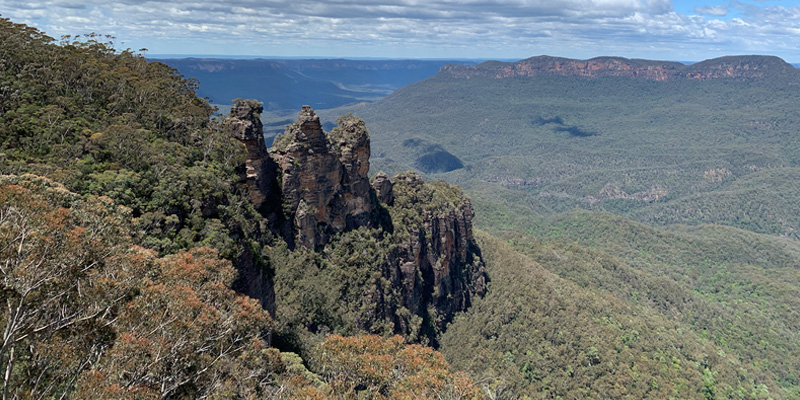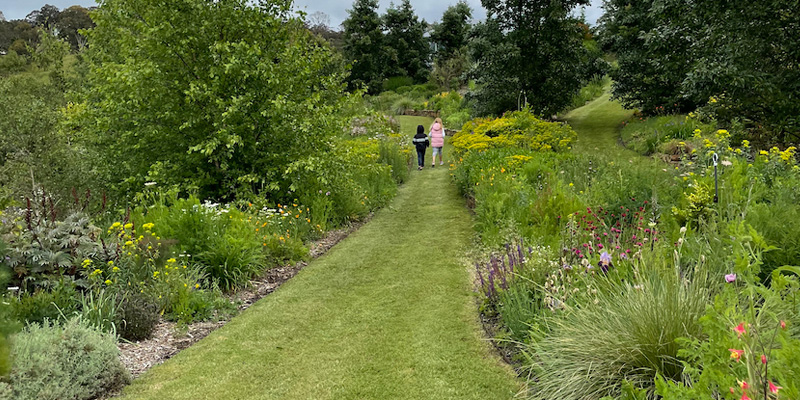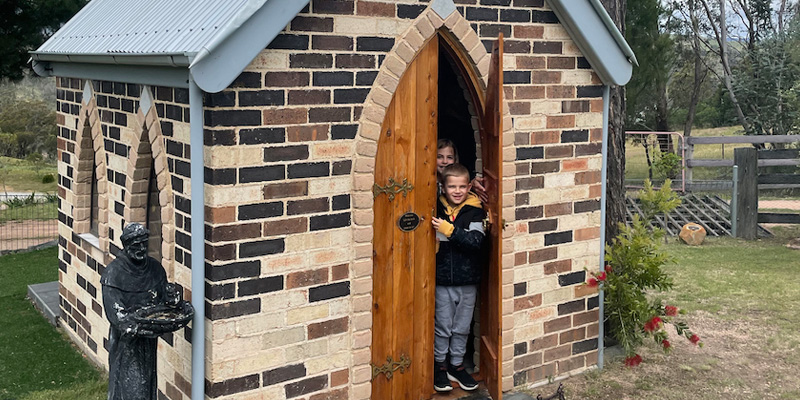Long playing second fiddle to Lithgow and associated with tedious school excursions, this forgotten village warrants closer examination.
Nearly every country town in NSW was founded with visions (and, in many cases, delusions) of grandeur. The surviving buildings in Hartley, a village west of the Blue Mountains, stand testament to this optimistic outlook.
Historic Hartley village
Most imposing is the courthouse, which first put Hartley on the map. Prior to its construction in 1837, there was no place to secure prisoners between Penrith and the foundling agricultural town of Bathurst, so colonial authorities decided to build one near the River Lett.
Designed in Greek revival style and constructed from finely hewn sandstone blocks, the courthouse remains largely intact today. It was an all-purpose edifice, containing a courtroom, magistrate’s chambers, and two prison cells (one for men and one for women). Supporting local law and order while housing prisoners en route to Penrith or Bathurst meant there could be up to 35 men crammed into a cell no bigger than the average lounge room. Some convicts etched their names into the hardwood framing and the inscriptions are still clearly visible.
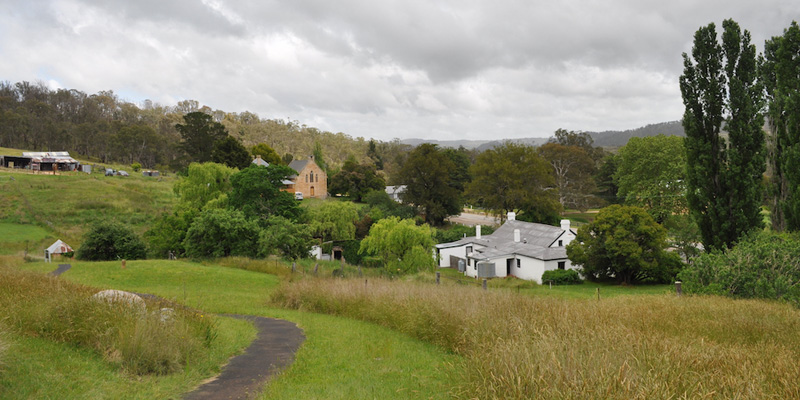
Historic Hartley Village (Photo by Kris Ashton)
Irish roots
But while the courthouse gave Hartley its initial raison d’etre, an enterprising family almost single-handedly turned it into a town. John and Mary Finn and their eight children arrived in NSW in 1839. The rector in their hometown of Tralee in Ireland had told the Finns about his son’s progress as a magistrate in Hartley, so they set out across the Blue Mountains to make a similarly fortunate life. They bought several plots of land and erected six buildings, five of which still stand today.
Throughout the 1840s, the Finn family ran the pharmacy, post office, and general store. When gold was discovered in Bathurst in 1851, Hartley served as a staging point for those headed west to seek their fortune and soon became a boom town. But in the 1870s a new rail line between Sydney and Lithgow bypassed Hartley and made the town obsolete almost overnight.
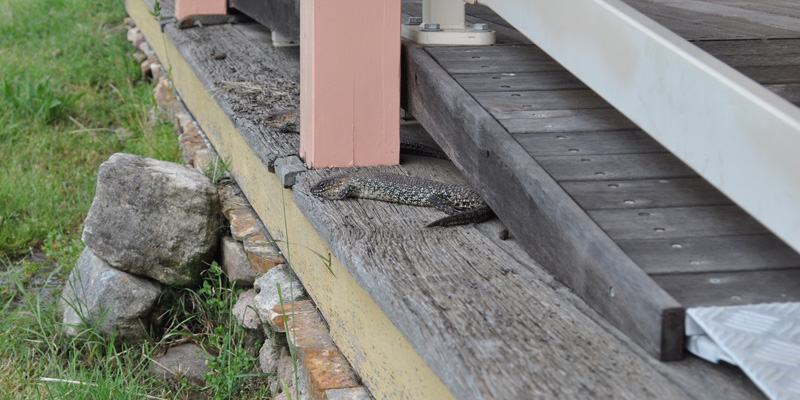
Old Trahlee (Photo by Kris Ashton)
It’s thanks in large part to another family, the Corneys, that we can spend a few days living Hartley’s colonial past. In the 1940s, the Corneys restored some of the town’s derelict buildings and made their own contribution, a service station, which still stands today and has itself been restored.
Old Trahlee and its Cunningham’s skins
Among the buildings preserved is Old Trahlee (spelling could be rather fluid until the 20th century), our lodgings during our stay in Hartley. Originally a Finn family residence, it retains many of its original historic features but doesn’t want for comfort, with two gas fireplaces, a continuous hot water system, and disabled access throughout. The only real limitation is the kitchen, which is functional but not likely to impress any wannabe MasterChefs.
When the sun comes out so does a trio of Cunningham’s skinks. These communal, blue-tongue-sized reptiles typically find respite in caves and logs, but they consider the hollow below the wheelchair access ramp on Old Trahlee’s front porch a more than acceptable substitute.

Field of Lavender (Photo by Kris Ashton)
The sunny aspect also encourages the humans in Old Trahlee to emerge and explore their surroundings. Up the hill, obscured from view at street level, is St John the Evangelist Anglican Church, which still conducts services once a month. It stands opposite the Royal Hotel that dates back to 1849, and it’s not hard to imagine a man sinking a half a dozen ales and then stumbling across the road to confess his sins.
Old Hartley and the Talisman Gallery
Back down in the lower section of the village is the old Hartley post office, which was completed in 1852 and served the community for 130 years before closing in 1982. In recent years, the Alexander family ran a café out of this historic building, but the double-whammy of a bushfire claiming their family home and loss of business due to COVID saw them forced to close the café’s doors.
Its side passage now serves as an entranceway of sorts to the smaller historic structures at the rear of the property (including a four-seat ‘privy’ dating to the 1870s) and the 350-million-year-old tor known as Kew-Y-Ahn, which sits atop a steep hill. My son is concerned it will tumble down, and it certainly gives that impression.
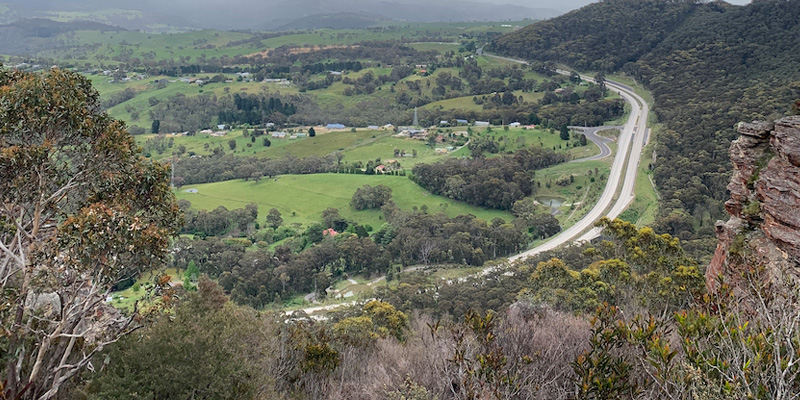
Hassans Walls (Photo by Kris Ashton)
Metal sculptures alongside the track hint at its ultimate destination, the Talisman Gallery. Owner, blacksmith Ron Fitzpatrick, creates metal sculptures and jewellery and you can watch him ply his trade downstairs or explore his gallery upstairs. His property neighbours more historic buildings, including St Bernard’s Church (its presbytery is also leased as accommodation) and the derelict Shamrock Inn.
Lolly shops and Hassan Walls
If you’ve ever travelled west of the Blue Mountains via the Great Western Highway, you’ve probably noticed The Lolly Bug. It’s hard to miss with its brightly painted Volkswagen Beetles, one a classic bug and the other the retro-styled version from the early noughties. There are a lot of lolly shops in country Australia, but we’d be surprised if another offers a wider selection of chocolates, lollies and chips from around the world. A visit is not recommended for those watching their waistlines.
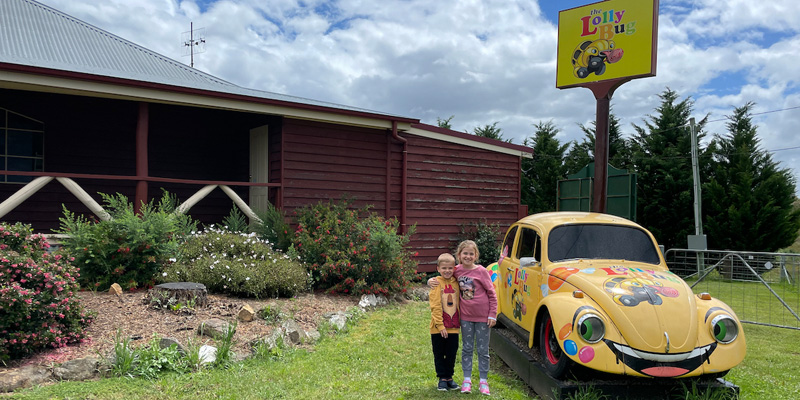
The Lolly Bug (Photo by Kris Ashton)
Loaded up with junk food, we take Browns Gap Road out to Hassans Walls, a remarkable geographic feature that historians believe Governor Lachlan Macquarie named after similar ‘walls’ he saw in India. Even more impressive than the walls themselves is the lookout, which gives an unbroken vista of Hartley and beyond. We can literally ‘see our house from here’, and when we return to Old Trahlee we’re able to pick out the ridge that provides the lookout’s eyrie.
Exploring neighbouring Little Hartley
The next day we set out to explore neighbouring Little Hartley. The area has become renowned for its ‘Central Tablelands Garden Trail’ – private gardens that are open to the public through the ‘My Open Garden’ project. But most pale in comparison to Highfield Gardens on John Grant Road and it’s not merely for those who like to stop and smell the roses. At the entrance, our kids are handed ‘treasure maps’ and they have to go around the maze-like paths ticking off hidden sculptures.
We almost miss the snail at the end until Cody trips over his own feet and, lo and behold, discovers it secreted in the bushes nearby. Upon our return we find little markets and a nursery where we can buy seedlings of the flowers we’ve been photographing. Tea, cordial and biscuits are served in the lavishly decorated reception area known as The Gatehouse and around the corner is a sausage sizzle.
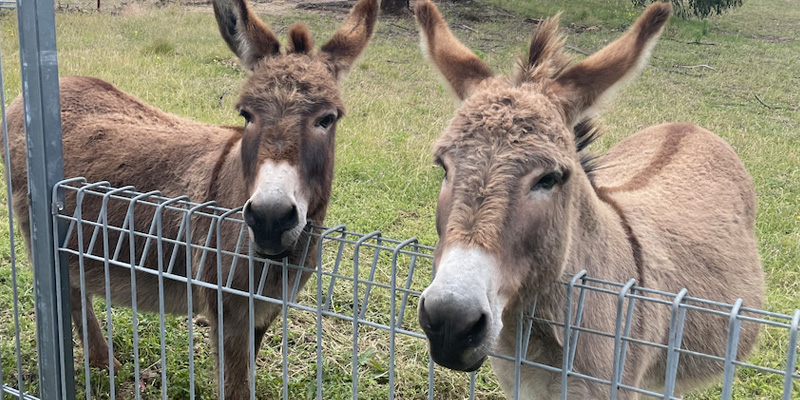
Two friendly donkeys in Little Hartley (Photo by Kris Ashton)
Tucked away in the hills beyond Little Hartley, the Tiny Chapel is, as the name suggests, a chapel in miniature, right down to its stained glass windows and a pew that overlooks the valley to the west. It’s located at the front gate to owner Sherry Weller’s property and she says she was inspired to build it after seeing similar chapels in the US mid-west in the 1970s. Most days her two friendly donkeys come down to the fence to welcome visitors. Like a pair of family dogs, the donkeys chase our Mitsubishi Outlander along the fence line to say farewell as we depart.
Red belly snakes at the River Lett
We take the trail down to the River Lett on our final morning. In recent years, this trail has been treated to a boardwalk fashioned from 16 tonnes of recycled plastic and timber waste, which should last 70 years. The river is flowing almost to rapids with recent rains and a short way along we encounter yet more historic buildings. Leslie Rowson constructed a hut and an electrical engineering workshop in the mid-20th century to serve his gold leases.
We take some photos on the river’s sandy shore and are about to depart when my daughter spots a red-bellied black snake crossing the path (just as well, I probably would have trod on it). The snake beats a hasty retreat under a rock, clearing the path for our safe return.
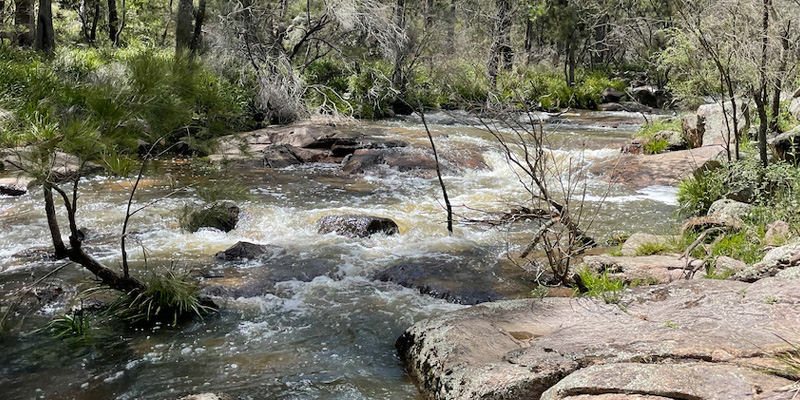
River Lett (Photo by Kris Ashton)
We then bid old Hartley village farewell and head up Victoria Pass, with a view to showing our kids the Three Sisters at Echo Point. As many a tourist has discovered, visiting the Three Sisters can be hit-and-miss – on a foggy day this famous formation is enveloped in an impenetrable white shroud. But the gusting winds work in our favour and, not only are the sisters visible, so are the breathtaking ridgelines and canyon-like valleys that surround them.
While the Blue Mountains has a multitude of interesting places to visit, it’s worth remembering the area between the mountains and Lithgow has an awful lot to offer, too.
